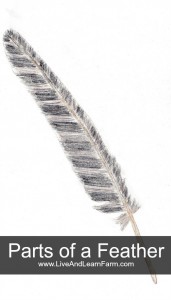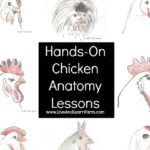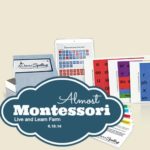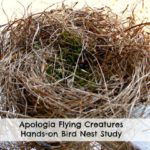As most of you are aware, we are in chicken mode right now with Gage’s business (Deluxe Clucks) starting and the brooder webcam up and running (see right sidebar and click play to watch). We have been contacted by some local homeschoolers to come out for field trips, so we are in the process of getting ready for them to start. As part of the homeschool field trips, I’m creating various works to help teach them more about chickens. This lesson is about parts of a feather and it is one of a series of posts on basic Chicken Anatomy. Be sure to visit the other posts too! You can find them here: Hands On Chicken Anatomy Lessons and Bird’s Nest study.
 Feathers are pretty amazing! They are extremely strong, yet lightweight. There are actually five basic types of feathers:
Feathers are pretty amazing! They are extremely strong, yet lightweight. There are actually five basic types of feathers:
- Contour
- Down
- Semiplumes
- Filoplumes
- Bristles
This would be a great time to go on a nature scavenger hunt to find some feathers. Grab a magnifying glass or a microscope to study your feathers more closely! If you do not have access to feathers or a microscope, here are some pictures and another set is here for you to be able to see them up close. For the Parts of a Feather study, I drew a contour feather. I will be creating a work about the various types of feathers. Here is a set of nomenclature cards I drew and made for parts of a feather.
Most feathers have a couple of feathers in common:
- Most feathers have a thick hard pole down the center of the feather. This is called the Shaft. It is made of Keratin (the same material our fingernails are made of). Birds cannot feel the shaft, therefore it does not hurt the bird to clip their wings.
- The Quill is where the feather attaches to the Bird. Quills were used to write with long ago. It was dipped into ink and the ink would go up the shaft a little way.
- The soft part of the feather is called the vane. If you can look at this part through a microscope or magnifying glass, you will see that it has tiny hairs called barbs. Those hairs also have tiny hairs called barbules. They function like a hook and latch… making the wing vanes act like a zipper.
- Some feathers are fuzzy, these are called Down Feathers. This is where the barbs do not have barbules so they cannot hook (or zip) together. Down feathers do not have a shaft. Every bird has down feathers under it’s contour feathers.
All birds molt. It is where the bird loses its old feathers and grows new ones. Why do birds molt? Simply, because their feathers get old and beat up. Most birds molt gradually losing a few feathers at a time. There are a few birds that lose their feathers all at once. Doesn’t that sounds like a great research project to figure out which ones do this?!?
If you don’t know where to begin to teach zoology to your students, we used Apologia’s Exploring Creation with Zoology, Flying Creatures Book. For more information about how I take traditional curriculum and make them more hands-on and Montessori-ish, look here under the Zoology and Botany tags.
I’ll be covering more basic anatomy information about chickens (and birds in general, like this lesson), so stay tuned!
You may also like -
Trish Corlew
Latest posts by Trish Corlew (see all)
- 10 Fun and Educational Preschool Board Games - April 25, 2015
- March Menu Plan for Busy Homeschool Moms - March 10, 2015
- Middle and High School August LinkUp #24 - August 5, 2014
- Modeling Life-Long Learning - June 23, 2014
- The New Chapter – Day 1 with Free Printable - June 20, 2014




Oh that’s really interesting. I didn’t know the parts of a feather.
Thanks for linking to the Sunday showcase.
What a terrific idea. Please share it (and any others) on my family-focused Kid Corner. You may just get highlighted next week 🙂 Jennifer
Very interesting! I learned a lot =)
Thanks for linking up to TGIF! I always look forward to seeing what you’ve been doing! Hope to see you again tomorrow,
Beth =)